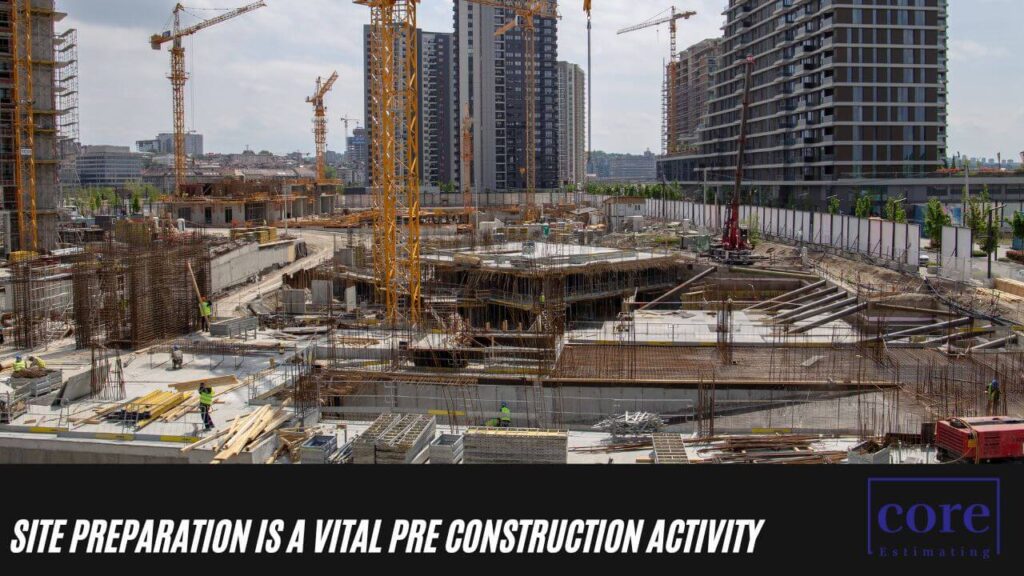We humans build structures ranging from single stories to skyscrapers containing stories spanning over a century. Regardless of their height, building structures are built on the ground. And to build these structures, you must first prepare the building land accordingly, otherwise the entire building is in danger.
Site Preparation the ground is perhaps the most important thing in holding everything together and ensuring structural integrity for centuries to come.
Let us understand site preparation and its encompassing activities.
If you’re in need of construction estimate services, simply go to homepage or follow the links below:
| Services | Links |
|---|---|
| Detailing Services | Link |
| Building Information Modeling | Link |
| General Contractor | Link |
| Subcontractors | Link |
| MEP | Link |
Site Preparation
Land around the world is not ready to suddenly accommodate concrete, steel, wood or other materials. It’s not even properly leveled and can’t keep walls and ceilings aligned properly. To address any concerns regarding the integrity of the building and prepare it for construction, site work is being carried out.
This process includes certain activities that clear the selected land of any contingencies and make it available for construction. As these activities are carried out before construction, an estimate of the site work is carried out before the site work is carried out.
Because the construction site is not an easy task. Applying inappropriate force can make the terrain worse instead of suitable for the project. But with the estimated details, site contractors know how to carry out all the relevant activities.
With that, let’s look at the different construction site activities.
Deforestation and uprooting
Weeds grow on land left unattended. Likewise, unwanted substances such as rubble, broken objects, trash, litter, leftovers and other things can be found on unattended grounds. All these things prove to be dangerous for construction and hence are disposed of during construction site work. This clears the land and allows it to contain construction materials.
Shoring and erosion control
The land is subject to bad weather and soil degradation. This can cause the foundations to collapse and in turn lead to the collapse of the building. Therefore, shoring and erosion are completely reversed. This paves the way for future stability and shelter from collapse.
Stabilization of the foundation soil
The soil itself does not have adhesive properties. This is why there is a risk of ground displacement and collapse. To keep this danger under control. The soil under the topsoil is stabilized. To do this, a stabilizing agent is installed. Otherwise, it can cause problems during the construction process and later after construction, in the form of cracks or other damage.
Excavation
The foundations are laid at a certain depth depending on the height of the design and other requirements. So, to lay the foundations, the ground is dug. This digging must be precise and the information provided in the on-site work estimation services is therefore vital. Then, the construction contractors lay the necessary foundations.
Drainage and water systems
Every man residing in the building requires certain facilities. These facilities require some underground facilities. Therefore, before actually installing the concerned system, certain tools, devices and supporting materials are installed underground. Only then will these systems and facilities be usable.
How does this process help with construction and residency?
With each construction site activity carried out and the construction site properly prepared, the construction and subsequent use of the building is made easier. To understand this facility, we must consider its constituent activities.
These benefits include:
The ground is stable. The danger of caving or any other is avoided. The construction process runs smoothly and can continue without interruption of work. Likewise, once construction is completed, the building is stable.
The insulation is solid. Buildings are designed to be isolated from the outside atmosphere. One of these methods is very bleak on the ground. In this way, a good foundation contributes to this.
Erosion is properly managed. Land may erode over time in the future. With proper erosion control, the risk of land erosion is eliminated. This gives a strong and lasting integrity to the building concerned.
Basic facilities such as water, electricity, heating, communication and others are available. Since today basic installations are operated via underground connections, adequate site preparation leads to their sufficient availability.
The land is completely ready for the construction process. Since the building plots are fully processed in accordance with the earthwork estimate and have been fully prepared, construction activities can be carried out according to the planned plan.
These are some of the frequent and common benefits of proper construction site activities.
What happens after the construction site?
Site work includes preparing the land and once completed, then comes construction. Prior to any sort of site preparation, the land contains debris, is irregular, contains unstable soil, may erode, and does not include any facility of supply for any system. But then the land is cleared, leveled, stable, protected against erosion and includes the necessary materials to facilitate the systems.
Once all this is done, contractors can look at the construction process itself, from the leveled ground to the final finishes.
Conclusion
Site preparation is an essential element of any construction project. This supports the selected land and prepares it for construction purposes. To do things right, the contractors concerned benefit from an estimate of the site work. Through proper site activities, the required construction is facilitated.






